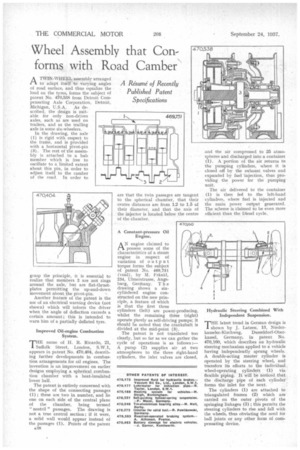Wheel Assembly that Con forms with Road Camber
Page 64

If you've noticed an error in this article please click here to report it so we can fix it.
ATWIN-WilEEL assembly arranged to adapt itself to varying angles of road surface, and thus equalize the load on the tyres, forms the subject of patent No. 470,538 from Detroit Compensating Axle Corporation, Detroit, Michigan, U.S.A. As described, the design is suitable for only non-driven axles, such as are used on trailers, and as the trailing axle in some six-wheelers.
In the drawing, the axle (1) is rigid with respect to the &mile, and is provided with a horizontal pivot-pin (3). The rest of the assembly is attached to a hub member which is free to oscillate to a limited extent about this pin, in order to adjust itself to the camber of the road. In order to grasp the principle, it is essential to realize that members 2 are not rings around the axle, but are flat-thrustplates permitting the up-and-down movement about the pivot-pin. Another feature of the patent is the use of an electrical warning device (not shown) which will inform the driver when the angle of deflection exceeds a certain amount; this is intended to warn him of a partially deflated tyre.
Improved Oil-engine Combustion System.
THE name of H. R. Ricardo, 21, Suffolk Street, London, S.W.1, appears in patent No. 470,404, describing further developments in combustion arrangements for oil engines. The invention is an improvement on earlier designs employing a spherical combustion chamber with a heat-insulated lower half.
The patent is entirely concerned with the shape of the connecting passages (1) ; these are two in number, and lie one on each side of the central plane of the chamber, being termed "nostril " passages. The drawing is not a true central section; if it were, a solid wall would appear instead of the passages (1). Points of the patent
a38 are that the twin passages are tangent to the spherical chamber, that their centre distances are from 1.2 to 1.5 of their diameter, and that the axis of the injector is located below the centre of the chamber.
A Constant-pressure Oil Engine.
AN engine claimed to possess some of the characteristics of a steam engine in respect of variation of output torque forms the subject of patent No. 469,751 (void), by M. Frank!, 234, Ulmerstrasse, Augsburg, Germany. T Ii c drawing shows a sixcylindered engine constructed on the new principle, a feature of which is that the first three cylinders (left) are power-producing, whilst the remaining three (right) operate purely as self-driving pumps; it should be noted that the crankshaft is divided at the raid-point (3).
The patent is not translated too clearly, but so far as we can gather the cycle of operations is as _o_'1 11 ows :— A pump (2) supplies air at two atmospheres to the three right-hand cylinders, the inlet valves are closed,
and the air compressed to 25 atmospheres and clischa,rged into a container (1). A portion of the air returns to the pumping cylinders, where it is closed off by the exhaust valves and expanded by fuel Injection, thus providing the power for the pumping unit.
The air delivered to the container (1) is then fed to the left-hand cylinders, where fuel is injected and the main power output generated. The scheme is 'claimed to be even more efficient than the Diesel cycle.
HE latest trend in German design is 1 shown by J. Latzen, 13, Nieder
kasseier-Kirchweg, Dusseldorf -Oberkassel, Germany, in patent Nu. 470,180, which describes an hydraulic steering mechanism applied to a vehicle having independently sprung wheels. A double-acting master cylinder is operated by the steering wheel, and transfers its efforts to the individual wheel-operating cylinders (1) via flexible piping. It will be noticed that the discharge pipe of each cylinder forms the inlet for the next.
The cylinders (1) are attached to triangulated frames (2) which are carried on the outer pivots of the springing linkages (3) ; this permits the steering cylinders to rise and fall with the wheels, thus obviating the need for ball joints or any other form of compensating device.




























































































